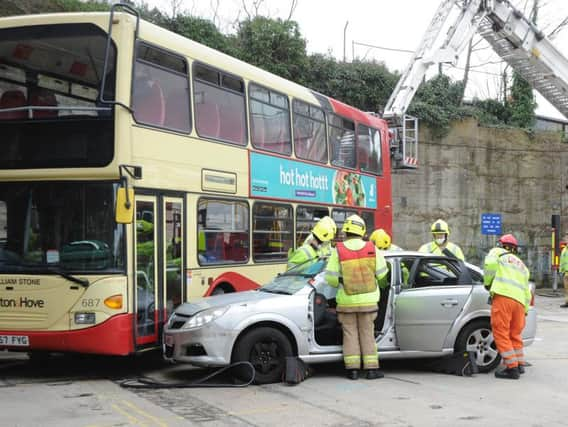Major bus crash mocked up for firefighter training run


East Sussex Fire and Rescue Service set up a simulation of a major accident at Brighton and Hove Buses' Lewes Road depot, with casualties trapped inside a double-decker bus.
Firefighters from Preston Circus, Roedean and Lewes fire stations attended the mock rescue scene, with four fire engines and a technical rescue unit.
Advertisement
Hide AdAdvertisement
Hide AdFire service volunteers and bus company employees were made up with fake injuries and wounds for their roles.
Jon Lee, the fire service watch manager who organised the exercise, said: “In the scenario the bus driver has had a medical episode at the wheel and caused an accident involving a car and a pedestrian. Passengers are trapped on the bus, a pedestrian is pinned under the wheel of a car, the car has ploughed into the bus doors so they can’t be opened and the motorist can’t move because of his injuries.
“This sort of training exercise is designed to refresh and test our firefighters in operations and processes around road traffic collisions that involve lots of casualties.”
Dan Young, Brighton and Hove Buses’ Lewes Road senior supervisor, said: “I’m very grateful to the fire service for giving us this incredibly useful and rewarding opportunity to help improve the safety of our community.”
Advertisement
Hide AdAdvertisement
Hide AdAt the training run, crew managers began by assessing the scene, the casualties and the severity of injuries before devising a plan of action. The simulation replicated reality by having the second set of two fire engines arrive after a delay having travelled from Roedean and Lewes.
Firefighters trained in immediate medical care and who carry defibrillators bridged the gap during the normal wait for the arrival of ambulance crews.
After a short while, they were joined by a mechanical expert and first aiders from Brighton and Hove Buses.
The practice involved ensuring the bus was safe, stabilising both the car and the bus with blocks to prevent further injuries. Then each of the crews attended to the different sets of casualties.
Advertisement
Hide AdAdvertisement
Hide AdThe pedestrian was released by jacking up the car with the aid of the blocks and air bags. The driver was rescued through the cab window, passengers in the lower deck were carried out while one injured passenger on the top deck was lifted out with the aid of an aerial platform. Cutting tools were used to slice off the top of the car to rescue the driver whose potential spine injury prevented him moving.
Jon said: “It was a really successful and useful exercise for us. It’s been good to have Brighton and Hove Buses wanting to get involved and get into the spirit of it. We couldn’t have done it without them.”